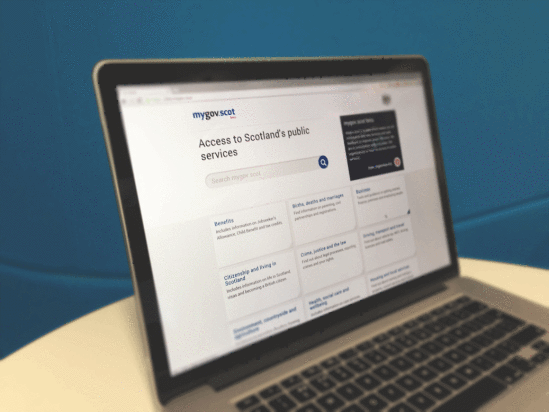Digital
Introducing beta.mygov.scot
February 17, 2015 by Jono Ellis No Comments | Category Digital Public Services, mygov.scot
This is a post by Peter Smith, Product Owner for alpha and beta
From today you can see the beta version of mygov.scot. This marks the start of a phase in which we will continually add content and features to the site, making use of the tools and processes we have been developing since the release of alpha. Care Information Scotland (CIS) and the Scottish Business Portal are amongst the first to work with us on content and we would like to thank them for working alongside the team on this early beta release.

What’s different from alpha?
When we created the alpha version of our site, our goal was to rapidly articulate the proposition and get as much feedback as possible from users and from our colleagues in Scottish Government. We’re seeking feedback on beta too. As well as continually monitoring responses to the on-site survey, user research is now embedded in the program of work informing our product design. However, our overall objective for beta is more than this. We want to produce a product and plan a programme of work that will take us into a live operating model in 2015.
Progress so far
When we started to think about our first beta release, we thought much bigger than just building on the alpha and calling it a day. Our overall ambition was to put in place the foundations that would allow us to publish public sector content at scale. This resulted in numerous activities being undertaken that won’t be visible to users when viewing pages on the site.
- A key difference with the beta site is that we have committed to only publishing fact-checked content. By this we mean that all of the information you find on mygov.scot will have been verified by the relevant public sector body, so our users can trust it.
- To achieve this we have had to create a process for how we engage with organisations and represent their services on the site. We’re continually adapting and improving this engagement process. It’s a balancing act between quickly delivering a comprehensive product for users, whilst also ensuring that our content is of an appropriate quality and is user focused.
- We have a process for discovering, verifying and accepting user needs when we engage with organisations. We are representing public sector services, but we know the user needs process that we are developing will help ensure this.
- We have successfully built the first iteration of our publishing platform allowing us to create and publish content end to end; from identified user needs to published content items on the site.
- Similarly, we have built tools to track our engagement with organisations, allowing us to build up a rich view of how user needs relate to services and organisations, and ultimately how these are presented on mygov.scot.
- Alpha feedback highlighted that we needed to better explain the scope of the site and what organisations would be included. We have created an index of all the organisations we intend to represent on mygov.scot across central government, local government, NDPBs and health. We call these hub pages, with each beginning to be populated with content. As we gradually take organisations through our user needs process, their content will start to feature on their hub page.
In summary, as well as being fully compatible on a wide range of devices (mobile, desktop, laptops and tablets), the mygov.scot beta and its associated activities will deliver a technical architecture to publish content at scale. It will also provide us with a greater understanding of processes and our approach to engagement with the public sector.
What’s next?
As we begin to expand the depth and breadth of the site, we will continue to work with Care Information Scotland (CIS) and the Scottish Business Portal alongside colleagues from Justice housing and Disclosure Scotland.
We’ll continue to update you on our progress over the coming weeks and months as well as feedback on the beta survey responses we receive in the next few weeks.
Tags: Analytics & Measurement, content, Design and User Experience, Search, Social Media, Standards & Guidelines, Technology & Digital Architecture, user research

Leave a comment